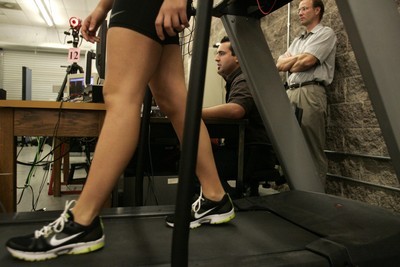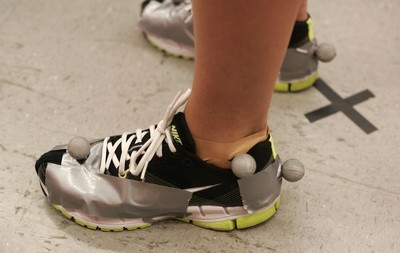BACKWARDNESS BENEFITS
First, she put on the outfit: tight shorts, a body-hugging tank top and a pair of running shoes.
Then, she taped tiny "disco balls" all over her body. More than a dozen of them, fashioned by hand, fastened from her ankles to her belly.
And then she walked, backward, again and again, while computers judged her and a couple of college kids pondered what it all meant.
She did these things not at a drunken frat party. She did them for science. She did them because she wants to save your grandma's life.
"Close your eyes," said one of the observers, "and tell me when you're ready."
Should we back up a bit?
Good, because that's what this whole thing is about: Going backward.
Specifically, it's about walking backward. It's about how doing the same thing you've always done, but doing it in a different way, might make you better than you were before.
Think of it like this: If you had to drive backward for a couple of weeks (under safe conditions, of course), wouldn't you learn to control your car better, and then be a better driver overall?
Yes, probably, you would. You'd be more familiar with how your car feels, and more ready for whatever comes your way.
Same thing here. Biomechanics researchers in the kinesiology department at the University of Nevada, Las Vegas theorize that walking backward, as therapy, might help people get around better in their normal lives.
It might help older folks who are prone to falling keep their balance. Which is a big deal. Falling is a leading cause of injury and death among older Americans.
This whole thing was born, really, two decades ago in Oregon, where researchers began studying backward running.
Janet Dufek was one of those researchers. She's now a visiting associate professor in UNLV's kinesiology department and is continuing her research. Kinesiology is the study of how the human body moves.
It turns out, running backward can have benefits for athletes. Various studies show it might reduce lower back pain. It can improve coordination. It can lessen the foot's impact with the ground and so lessen the injuries and strain such impact commonly causes runners.
This idea about backward running -- called "retro locomotion" in academic circles -- has really taken off in some places. Professional athletes have been known to run backward in training. There are entire races in Europe dedicated to backward running.
But walking? Not so much. It's been studied only a little, and hasn't really caught on in public.
And then, this.
Dufek said she read about a grant that the Bertec Corp. was offering, via a competition. Bertec is a leading manufacturer of force-measuring devices, machines that measure balance for those in the academic and health care fields.
So, she mentioned this competition to a couple of UNLV graduate students, Jennifer Aldridge and Geoffrey Melcher.
Aldridge, 24, is a runner. She's from Northern California, graduated from Sonoma State University, loves studying kinesiology. She's intensely interested in running shoes.
In fact, she chose UNLV because of all the work done there studying that sort of thing.
Melcher, 25, grew up in Las Vegas. He graduated from Green Valley High School and UNLV. He got into kinesiology because he tore his rotator cuff as a teenage snowboarder. This led to an interest in the medical field, which led to a pre-med major, which led to courses in physics and biomechanics, which led him to change his major.
So, these two, both of whom expect to earn master's degrees in kinesiology soon, were given a challenge: Get that grant.
The competition would be fierce, with researchers across the country writing proposals for projects that would have something, anything, to do with balance.
As a prize, the winners would get the use of pricey Bertec equipment for a year.
So, Aldridge and Melcher put their heads together with Dufek's. They thought about balance. They thought about what research they were already familiar with, some of which happened to involve backward running.
Running. Balance. Backward.
What about walking backward as a way of improving balance? Would that work?
The students wrote up a grant application, 75 pages of dense science titled "A Retro Locomotion Protocol to Reduce Postural Sway: Implications for Fall Prevention."
And they won. Theirs was one of nine teams to get a grant, which was announced in February.
And they set to work. They recruited subjects, generally in two groups: young and healthy, and older.
They measured these subjects walking backward in their lab, the Sports Injury Prevention Center on UNLV's campus.
They put those disco balls -- reflective balls for a motion-capture system -- all over the subjects' legs and torsos so cameras attached to a computer can watch. They analyze things like sway and motion and balance in the computer.
The other day, fellow grad student Dana Forrest, 21, showed off the system. She was the one with the disco balls all over her skin.
"I was really good in practice," she said when she messed up the backward walking a little.
It does take practice. You can't see where you're going, of course, and it's just awkward in general.
But with practice, you can get good at this. Which is the whole point of this study.
Aldridge said there are generally three body functions that regulate balance: vision, feeling, and sense of space. Walking backward might improve all three.
It could help vision by training your body to be more aware of what's not right in front of you.
It could help your feelings about your relationship to the ground because you've got to pay more attention to it when you can't see it.
And it could help your sense of where you are in space for some of the same reasons.
"Hopefully," said Dufek, the professor, "by practicing new types of movement, we're talking about developing the neurological system."
So, after measuring their subjects in the lab, the researchers send them home with instructions to keep it up for a few weeks. The subjects come back to the lab then and get measured for balance with that fancy grant equipment.
This final step hasn't happened yet, but the hope --- the hypothesis -- is that the subjects will show improved balance after a few weeks of walking backward.
Maybe the older subjects will improve more than the younger subjects.
If all that's so, well, possibilities abound.
Maybe those who show a propensity to lose their balance --- especially older people -- will have a new way to improve their balance. There are no drugs involved, and it's virtually free.
Once this stuff gets written up in the professional literature, doctors and physical therapists might begin prescribing it as treatment.
Maybe, in a few years, after it catches on as a nationwide phenomenon, the elderly will stop falling so much. Maybe those 1.8 million elderly people the Centers for Disease Control says went to emergency rooms in 2005 because of falls won't fall anymore.
Maybe the 15,800 elderly people who died as a result of falls that year, the latest for which numbers are available, will serve as a reminder of the way things used to be.
Or maybe not.
Maybe the research will be one step toward another grant, toward more money for UNLV's researchers, toward more studying, toward a slightly better understanding of how our bodies work, of how to make them work better.
Maybe it'll spark interest in the students who follow these two. And maybe those new students will discover something extraordinary by building upon the work of those who came before.
Which is really what this is all about.
Contact reporter Richard Lake at rlake@reviewjournal.com or 702-383-0307.


















